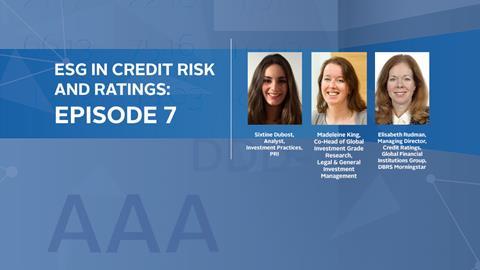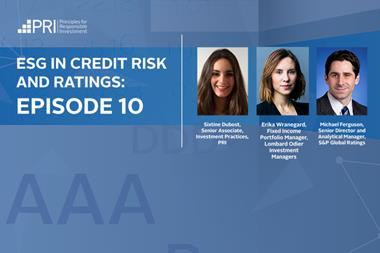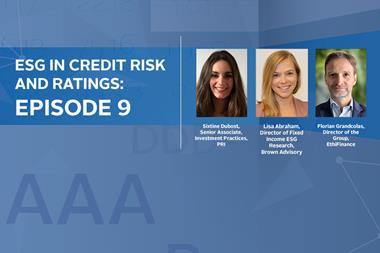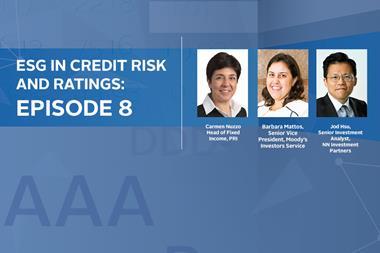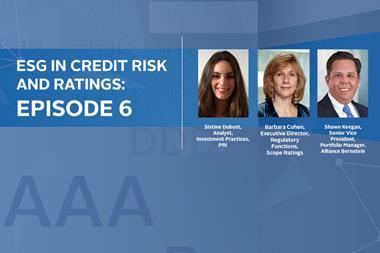In the seventh podcast of a series on the ESG in Credit Risk and Ratings Initiative, Sixtine Dubost (PRI) speaks with Madeleine King (Legal & General Investment Management) and Elisabeth Rudman (DBRS Morningstar) about governance factors, how they affect the probability of default of an issuer or of a bond issue and why their relevance is increasing.
ESG IN CREDIT RISK AND RATINGS: EPISODE 7
Sixtine Dubost, Analyst, Investment Practices, PRI,
Madeleine King, Co-Head of Global Investment Grade Research, Legal & General Investment Management
Elisabeth Rudman, Managing Director, Credit Ratings, Global Financial Institutions Group, DBRS Morningstar
Note: The Principles for Responsible Investment podcast is designed to be heard. If you are unable to do this, this transcript offers an insight into the episode.
Transcripts are generated using a combination of speech recognition software and human transcribers, and may contain the occasional error. Please check the corresponding audio before quoting in print.
Subscribe to the channel via Apple podcasts, Spotify, or wherever you listen to your podcasts.
Sixtine Dubost, PRI
Madeleine King, Legal & General Investment Management
Elisabeth Rudman, DBRS Morningstar
Sixtine Dubost, PRI
Welcome to this new PRI podcast, which is the seventh of a series on the ESG and credit risk and ratings initiative, one of the PRA flagship programs. My name is Sixtine Dubost and I’m a fixed income analyst at the PRI. And for over five years, the ESG and credit risk and ratings initiative has been encouraging, fixed income investors and credit rating agencies to incorporate ESG factors in credit risk assessment, more transparently and more systematically. And today the initiative is supported by 172 investors and 26 credit rating agencies. And the number of supporters continues to grow as we welcome new signatories on a regular basis. I encourage you to listen to previous podcasts of the series and especially the last two, where we looked at environmental and social factors, how they affect the probability of default of an issuer or of a single bond issue and why their relevance is increasing.
And today, um, as we focus on the last pillar governance, I’m delighted to be joined by Madeleine King, Co-Head of Global Investment Grade Research at Legal & General Investment Management, who will represent investor’s voice and Elisabeth Rudman, Managing Director, Credit Ratings, Global Financial Institutions Group, DBRS Morningstar, who will speak about how governance factors are incorporated in credit ratings. So welcome to you both, and thank you for taking the time to be with us today. And to start off, um, of the three categories, E S and G, the governance pillar has traditionally been the predominant one in fixed income analysis. We often hear from investors and credit rating agencies that without solid governance, it’s difficult to achieve functioning E and S pillars. So in your respective roles, what relevance to governance factors have, and as Beth, maybe we can start with you and the Sierra perspective, and then Madeleine will share her focus as an investor.
Elisabeth Rudman, DBRS Morningstar
Sure. Thank you. Yes. I think it’s safe to say that, you know, governance has been a key part of the analysis for credit rating agency perspective for a very long time. So we’re looking, um, decades past, it’s been explicitly set out as, um, as part of our analysis and really having good governance, whether it’s the, um, the shareholder structure, the board structure, issues such as political risks or business ethics, all of those things go to the heart of how an institution is run. And, um, it feeds into all the traditional building blocks that we look at as part of our rating analysis. So whether that’s looking at the franchise of an entity and their earnings, which can be affected by poor governance, uh, risk factors, um, also funding because the deposits can be affected by confidence, um, for a financial institution and capital, if there are losses that are involved.
So, um, I think we’re, we can all think of many examples of, um, bad governance. We certainly saw many during the financial crisis. There were failed institutions across Europe and north America, much of which related to governance. And we continue to see issues in terms of financial institutions and particularly money laundering or, um, more recent examples, um, Credit Suisse governance issues with regards to they had, um, senior management and a sort of espionage issue, also, um, argos and green sill, these types of issues. They continue to crop up and feature in the analysis. And just one last point, which is that certainly there can be broader governance issues, which may not necessarily feed into the credit analysis at this point. So some of the issues that could be, um, relevant for fixed income investors and, um, Madeleine might say more about it, but in terms of, from an ESG perspective, whether it’s like board diversity or something like that may at this point, not necessarily have an impact on the credit fundamentals, although it may be something that with time and with shareholder pressure or with regulator pressure, those types of issues may become more important in the future.
Madeleine King, Legal & General Investment Management
I would agree with everything Elizabeth has just said, all of those points are definitely relevant from a, from an investor point of view. And I think, um, governance, it’s um, it is something that investors have thought about really since credit analysis began. We didn’t always call it ESG, but I think as a, as a credit investor, you have to make some sort of assessment of management before you can invest in a bond. You have to some sort of comfort that, that our being well-run and governed properly. So even, even before we were measuring this sort of thing on a, on a more consistent basis and, and maybe, maybe comparing things across sectors and so on. Tt was certainly something that the investors were thinking about. And as Elisabeth mentioned, when, when governance goes wrong, it can really, really go wrong. And really any, any disaster you had to dimension from a credit investor point of view over recent years, you can, you could always link it back to bad governance. You know, this, this oversight wasn’t being done properly or management just missed some major risk factor, or, you know, the, at the very extreme something like an accounting scandal. And, um, and basically think, I think bad governance is just, you know, the, the easiest way for credit investors to lose money.
Sixtine Dubost, PRI
Yes, exactly. To your point. Um, it hasn’t always been called, um, ESG and specially governance, but when been looked at, and, um, it’s, um, the, what is different now is the design posting, um, of these factors in credit risk analysis. And the ratings is more transparent and also more, um, systematic. And just saying, would you Madeleine, how do you see the relevance of governance factors evolving in the future now that environmental and social issues are being increasingly considered? And we see more interconnections between the three categories.
Madeleine King, Legal & General Investment Management
Now that we’re measuring more, more things. Now that we’re gathering more data, it sort of, it may be highlights risks that we wouldn’t have seen in the past. So, um, things like governance around climate, we wouldn’t have maybe explicitly talked about that five or 10 years ago. And now it’s something that I think really all investors are quite focused on and very aware of. And, and if they’re not, they certainly will be in the near future, I think. Um, so I do think, um, I do think the more data that we get and the more information we have, it will start to be analysed more, more rigorously by the market. And at some point I think that has to be reflected in, in how companies perform, how bonds trade and the, yeah. Basically the better information that we have, the more the market’s able to press in. And
Sixtine Dubost, PRI
And Elisabeth, you touched upon that earlier, um, briefly, but given your focus on financial institutions, is there anything else that you would like to add or which differs from what Madeleine just said?
Elisabeth Rudman, DBRS Morningstar
No, I think, but it’s, um, I agree with, um, her points and I think it’s interesting that, um, that when there will be yes, new challenges, governance challenges for organisations, and even, um, away from ESG itself, things are revolving for all institutions and whether cyber risk is, um, one kind of risk, which perhaps wouldn’t have featured so highly, um, in the past, but is increasing in terms of, um, the potential impact it can have on an institution, although not an easy one from the outside to be able to assess until something actually goes wrong, then, then you can see.
Sixtine Dubost, PRI
And, um, now, um, if we consider the different time horizons of the bond market, which has permitted that equities do not take it to account by definition, would you say that governance analysis differs for short term versus longer duration issuances? Um, maybe starting with you Elisabeth and the credit rating agency point of view.
Elisabeth Rudman, DBRS Morningstar
Yeah. From the rating agency point of view, we’re not actually looking at the duration of the bond. So we’re assigning a fundamental rating, um, it’s, uh, a medium to long-term horizon that we look at, uh, certainly the case with broader ESG issues and particularly on the east side, that that horizon presents greater challenges because some of the climate type risks evolve over a much longer period of time.
So I don’t think there’s anything, um, particularly changing from a horizon perspective for governance. Um, the only, the one particular issue that we always face when we’re assessing an institution is how long we continue perhaps to, you could say penalize and the rating for, um, an institution where they’ve had a feeling or a mistake, um, in governance. And that’s on a case by case basis, depends on how large the, um, the issue was, what steps have been taken to address it, how they’ve been, um, interacting with their regulators. So those are the kinds of things that are interesting to us in terms of horizons from a rating agency perspective.
Madeleine King, Legal & General Investment Management
I’d say it’s fairly similar from an investor point of view. Um, as much as obviously there’s higher governance risk in a very long dated bond, you know, there’s a higher average than risk in a very long base of bonds. Um, but primarily I think when you’re on the line as any bond, you start by analysing the company. Realistic if I’m looking at a five-year bond versus a 30 year bond, most of these risks, I don’t, I don’t know when long term it’s going to turn into short term. So if I’m concerned about the governance of a company over the next 30 years, why would I not be worried about it over the next five years as well? Um, when, when things go wrong, you know, it’s very difficult to, to kind of pinpoint when, when bad governance is going to turn into some sort of crisis, it could take 10 years, it could happen tomorrow. Um, and I think sort of trying to be cute about like guessing these time horizons, it’s a, it’s a bit of a fool’s errand. So I think you have to, if the risk is there, you have to think about it for every single investment that you make.
Sixtine Dubost, PRI
It makes a lot of sense. Um, and, um, yeah, Elisabeth, your points, how long a, a scandal will weigh on the, companies also something that, that should be considered if the company’s making efforts. And, um, Madeline the fact that the time horizons can be come quite blurry with governance is also, um, a very, um, you know, crucial point that you’re making. And now if we, if we focus on the actual metrics, um, we often hear from our signatories, that G is the first pillar that they look at. Um, and we mentioned that earlier, um, Madeleine as an investor, how do you assess corporates on their governance and how do you consider regional differences as well?
Madeleine King, Legal & General Investment Management
So I think the data-driven part is very systematic it’s, uh, there’s some very, um, well kind of documented ways of monitoring board composition and independence, all of, all of the kinds of structures around management. And there are definitely some regional differences there. And then you don’t want to kind of apply, um, a, an Anglo-Saxon view of the world to some Asian jurisdictions, for example. And I think you’ve, you’ve gotta be mindful that that not everybody has the exact same, um, operating model. Um, but I do think it’s with all of the SG, it’s really easy to kind of get focused in, on, you know, the data points and what does this turn into as a score out of 10, um, or, or whatever.
But, um, I think it’s really important to think about that, that qualitative judgment as well. And that’s true for every element of ESG, but I would argue for GE in particular, it’s, it’s, it’s difficult to measure. It’s difficult to quantify, but understanding the, the, the capabilities of the management, you know, do you have the right people in charge of this company and does their strategy make sense over a, over a long term horizon? That’s really crucial. Um, and then understanding really what’s driving the decisions of, of, of that management team, who are the shareholders? What, what are their objectives, how are they balancing the interests of bond holders versus equity holders? All of that is extremely difficult to capture in a data point, but it’s absolutely crucial to credit analysis. And I do think it’s something that, um, that kind of sometimes falls by the wayside a little bit when people are sort of trying to measure ESG risk, because it’s not easy to put in a spreadsheet, but it’s absolutely crucial to investment decisions.
Sixtine Dubost, PRI
And, um, what about you Elisabeth? And it’s how to find where the common risks for sovereigns financials and from the Sierra perspective, and how does this differ from the corporate non-financial debt issuers?
Elisabeth Rudman, DBRS Morningstar
Um, well, I very much agree with the points that, that Madeleine made, and certainly especially on the qualitative, um, elements. And so that does make it hard to have some kind of very clear comparisons between institutions and, and in the end, it requires digging into an individual institution and discussing, and yes, you can make certain, um, comparisons which are useful within a country. And you can learn from, from where you’ve seen. Um, I mean, we’re all aware that they’ve been a number of corporate governance challenges say for Italian banks where the shareholder structure foundations, um, led to difficulties in managing those institutions.
So there are some things that you can see in terms of patterns, um, across institutions, but I’m not sure if it does remain, um, dependent on an individual institution. Um, I think that between corporates and financial institutions, it’s many of the same issues that we’re looking at, you could say that perhaps for financial institutions, governance can weigh even more heavily on the rating, given that they are regulated. And the confidence is so important for, for a bank. And if something goes wrong, that can affect the confidence of deposit holders. And, uh, and there are a few things which are perhaps slightly different for sovereigns in terms of that you’ve got political risks that you might be looking at and transparency as similar issues, but applied in a different way. So how is, um, is the independence at the central bank, um, how, how elections managed and all of those things that can have a broader impact on, um, on the economy and risks.
Sixtine Dubost, PRI
And to close our discussion, I would like to address, um, an important final point, um, because as opposed to equity investors, bond holders do not have voting rights and had to use all the channels to ensure, um, active ownership, but given the significant size of the bond markets, it’s really important for fixed income investors to engage. And in the workshops that the PRI is organising with, uh, credit analysts, uh, from both the investor and the Sierra sides and company representatives, um, analysts and portfolio managers claim that engagement is at the top of their agenda. But at the same time, we’ll also hear issuer saying that they do not receive a lot of ESG questions from their fixed income investors. So Madeleine as an investor, uh, how important are direct conversations with the top management of companies and other stakeholders in, in assessing their governance specifically?
Madeleine King, Legal & General Investment Management
So I think for assessing governance, it’s much easier to do that on the, especially on the qualitative side, if you have good access to management. Um, a lot of, a lot of that, um, judgment around is the strategy, right? Either, either right. People in place to manage this company is it’s very hard to do that. I think without that sort of access. And there’s a large investor were very fortunate, illegal in general to have, um, have the ability to have these conversations with management. Um, I would sort of separate it slightly from the, from the kind of pure engagement in terms of sort of pushing management teams for change or, um, or for kind of getting our message across because, because they are, I think is absolutely crucial and you can’t really do that unless you have scale. And unless you have that relationship with, um, with those management teams.
And, and again, I think we’re very fortunate that we have, um, large, uh, holdings and, and a lot of these firms on both the credit and equity side and the, on a well-established investment stewardship team as well. Um, and so your point of how, um, how do you engage as credit investors? Our view here is that, um, we sort of, we shouldn’t be doing it alone. Um, these are the same companies and they shouldn’t be getting a different message from our equity team than from our fixed income team and, and, uh, the different one again from investment stewardship. So we think it’s really important to be joined up and, and be given that same message. And, and you’re absolutely right. We don’t have the ability to vote, um, uh, on, on behalf of the bond holders, but we do have the rights to not lend them money. So it’s not that this voice, isn’t a powerful part of the equation. Um, and I think we under the asset managers should absolutely be using that voice.
Sixtine Dubost, PRI
Yeah, you’re absolutely right in, um, the ability to vote is not necessarily related to, um, proper engagement you can. And what you said is really interesting because this is also what we hear from investors as suggestions, um, uh, during these workshops that are more collaborative engagement between equity and fixed income teams and great rating agencies also play a major role in this, um, and, and have better nature of their work, constant access to top management and other issue representatives. And, uh, while recognising the importance of engagement, the SMLs who considers that long-lasting relationships with the same rated entities could’nt, um, compromise, uh, the independence of rating analysts, Elisabeth wa what are you thought on the rotation requirements between an integral teams, um, from the European regulator?
Elisabeth Rudman, DBRS Morningstar
Yes, so that has been introduced, and I think it was perhaps yes, this concern from the regulator of rating agencies, that there could be some conflict if an analyst is covering the same institution for a very long time. So that could be questioned because there are both benefits, um, as well as disadvantages from having the same analyst covering an institution. And I don’t think we see it as a conflict given that all analysts are completely removed, certainly from anything, um, commercial to do with the rating relationship, however, it’s, it is what it is. And actually there can, as I mentioned, there can be some benefits from another rotation because you get a fresh pair of eyes to, uh, to look at an institution and, um, and sometimes that’s that is needed. And that is also though for what we use the rating committee process for as well.
So to have that way of having different people, looking at the same, the same issues, um, and, you know, the disadvantage is that you have some, a slightly more complicated system to ensure that you’ve got people with enough experience and the right language skills to, um, to be covering the entities, but we work within the system. And, um, going back to the, um, original points that you made as well about ESG questions, I think, you know, again, as Madeleine said, governance questions have always been front and central to everyone’s engagement with issuers. Certainly it’s a bit different on the E and S, which has come in more recently and perhaps the impact on the ratings is less clear, but, you know, with the new guidelines, we, as the rating agency, we are obliged to now make it very clear in our press releases. And we also do the same in our research where these different E, S and G factors are and how they come into play. So I, I think that is helpful, um, for investors now, because it’s easier for them to look across and to see how a rating agency is looking at this governance issue across institutions, which, um, which is, you know, an important and challenging one and, and hard as well at times from to, to be from the outside, because sometimes the, you know, clearly the entities themselves don’t even, aren’t aware of their governance risk until it goes wrong. So I think that’s the kind of challenges that we all, we all face
Sixtine Dubost, PRI
Many, many things to you, both Elisabeth in Madeleine and sprayed that we’re running out of time. There’s much more that we could cover, but unfortunately time is never enough. Um, so again, thank you. I hope our audience found this podcast insightful. I know I did. And further reminder to the audience that you can find all the ESG and credit risk and ratings initiative, um, output on unpri.org/credit-ratings on the same page. You can also listen to the first six podcasts that we did and, um, and read the highlights of the workshops that I mentioned earlier. And finally, it’s never too late to sign a statement of support for the initiative. Again, can reach out to us by writing to [email protected] for more information, if you have questions or suggestions. So thank you for listening to today’s podcast. I hope that you’ve enjoyed it and will join us for the next one and until then keep well and goodbye.
Downloads
The Principles for Responsible Investment podcast transcript
PDF, Size 0.22 mb


